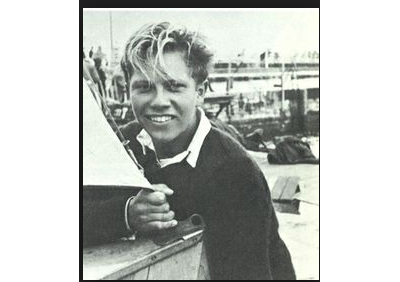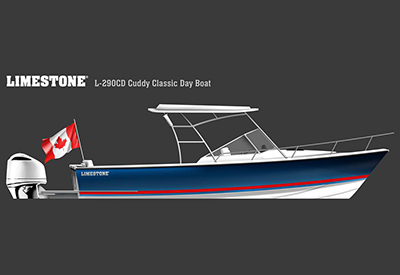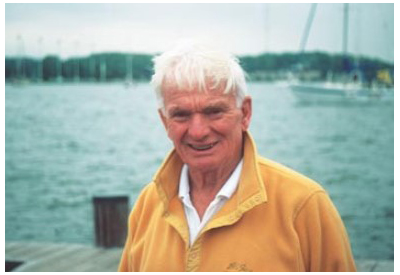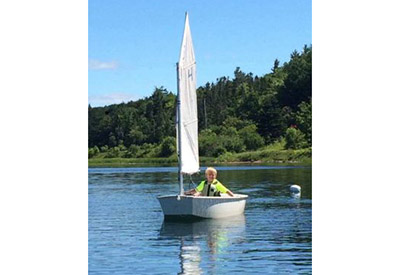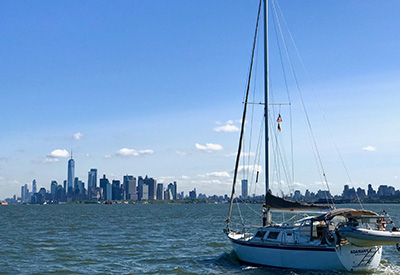Crossing the ocean in the Atlantic Rally for Cruisers (ARC) in a new Nautitech 44 Open
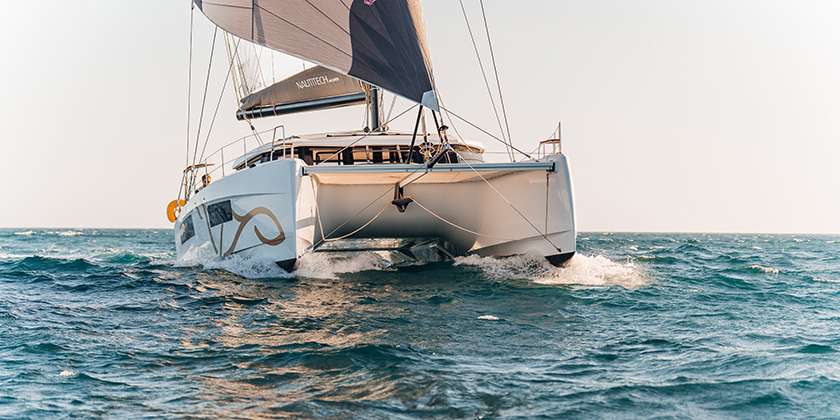
By: Max Shaw, photos by Peter Hunt and Nautitech
“Hello, old friend,” I said as I surveyed the clear sky and settled into my comfortable place at the helm. The constellation Orion gazed at me silently, a welcome offshore presence after four years ashore, while SV June’s sleek hulls cut cleanly through the waves.
This Atlantic crossing, aboard a brand new Nautitech Open 44, had been initiated several years earlier, shortly after my wife and I finished our 36,000 nm trip around the Pacific with our children. Upon our return, we began helping other families set off on similar adventures, initially in a training role and then through yacht brokerage. It was in these roles I met Peter and Natalie Hunt and was able to help with their grand adventure.
I am privileged to spend time on dozens of boats and often help others head out sailing, but longer offshore trips rarely fit into my work schedule. After Peter and Natalie narrowed their choice of vessel to a 2023 Nautitech 44 Open, I mapped out various longer-term itineraries that included crossing the Atlantic as part of the Atlantic Rally for Cruisers (ARC). While they were experienced sailors, they had never crossed an ocean as a family before – let alone with their children – so I promptly volunteered to assist. I had about 55,000 nm of experience including one disastrous Atlantic crossing (another story altogether …) but my catamaran experience had been limited to racing, sea trials and local deliveries. Here was an excuse to get back offshore again – I like to think of this as my natural habitat – and spend some quality time on a performance catamaran.
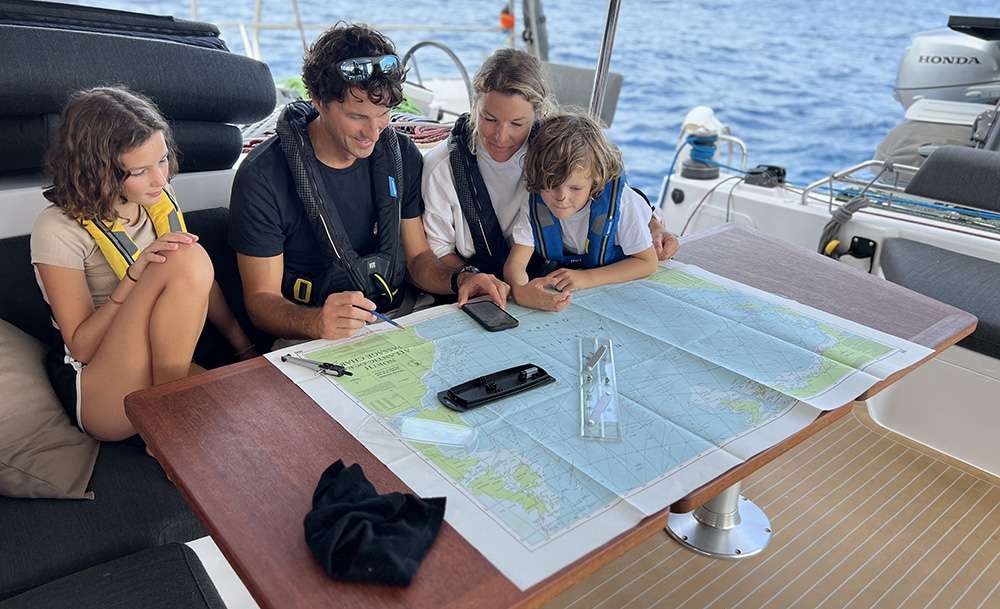
Their vessel was ready in May 2023, so I flew out to the Nautitech factory in La Rochelle, France for the handover and orientation. It was great fun to sail together, and it was certainly not a hardship to stay in La Rochelle. Peter, Natalie, and their children then cruised 4,800 nm through the Mediterranean on both the European and African coasts before sailing down to the Canary Islands, where I met up with them in November 2023 for the ARC preparations.
The ARC is one of the longest-standing rallies in the world, and really started the whole trend of cruising rallies. Every year, over 200 boats sail the 2,700 nm from Gran Canaria to St Lucia. Despite the ARC’s stellar reputation, as a self-described independent sailor, I must admit to some initial misgivings and preconceptions. On arrival, I was immediately impressed by the quality of the program and the level of organization, and my doubts were quickly dispelled. The safety inspections and seminars went a long way to preparing the fleet, and the many activities meant that the participants (typically more than 1,200 sailors) developed cohesion right from the beginning of their Atlantic adventure.
The clever ARC staff (a.k.a. “Yellow Shirts” due to their brightly coloured and distinctive attire) assigned the 12 “kid boats” to the same dock. Before long, the 20 kids from eight different countries were fast friends, and their parents enjoyed an instant social network as well. The “Yellow Shirts” seemed to be everywhere at once, always ready to assist and help.
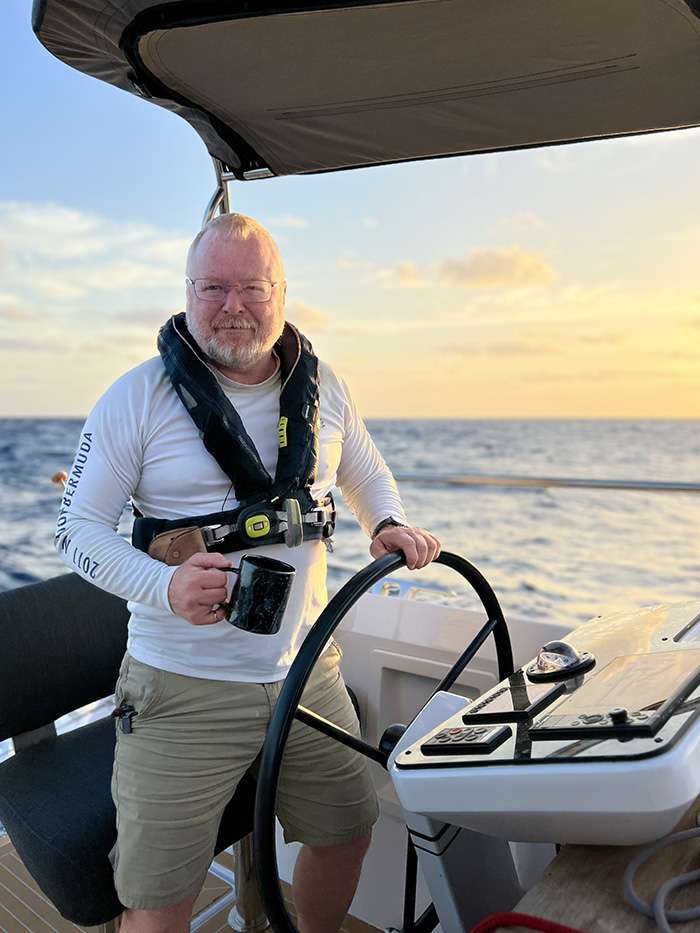
As with many major undertakings, one of the keys to successful offshore passage-making is preparation. I flew out to the Canaries a week ahead and we checked over the rig, engine, and systems to ensure we caught any problems early. We ensured halyards had Kevlar sheathing in critical spots and backed up other areas with Dyneema loops. People often underestimate the relentless fatigue experienced by an offshore sailing rig, and after the ARC, it was interesting to hear how many of the spinnaker and halyard dramas could have been prevented with a bit of preparation.
Provisioning for a passage is an art unto itself. It is hard to gauge how much food to bring and no one wants to worry about running out, especially with children onboard. Natalie and Peter ensured that we had the supplies to eat very, very well and it seemed that we could have sailed straight back across the Atlantic with the food we had onboard!
Before long, the seminars, the provisioning, the checking and double checking – oh, and the parties – were finished and it was time to cast off lines. Having completed a few offshore races, I am used to starting lines, but the ARC provided an amazing spectacle, with a band ashore and boats ranging from 34’ to 100’ jockeying for position in the light air.
With the sound of the gun, we were off! Peter, Natalie and I went into our watch rotation, and the kids, as kids always do, adapted quickly and fell into a pattern of homeschooling and helping onboard. When my wife and I do our seminars on offshore sailing, people often ask what we do to keep busy. Somehow the days always seem full and pass quickly! We checked the weather with Predictwind twice a day and debated routing strategies. Food needed to be prepared and dishes cleaned. Boats always need some care and attention, and we did daily checks of the rigging and steering. The kids completed their schoolwork, and I put my instructor hat on to cover the CRYA Yachtmaster Offshore curriculum with Peter and Natalie. With a washing machine onboard, we even did laundry most days!
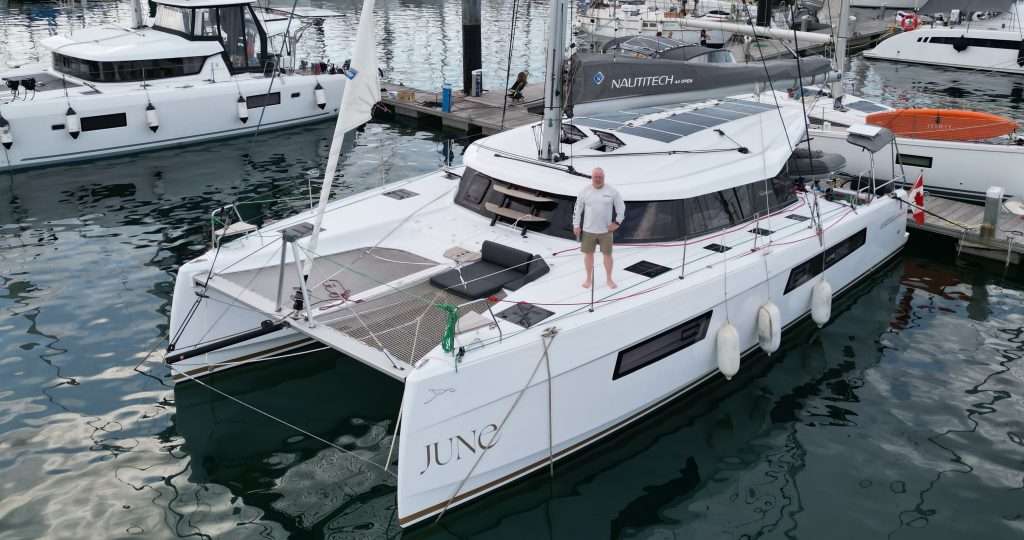
Even with all these chores, there was still time for watching the stars, sitting on the trampoline or in the “dolphin seats” for the frequent dolphin shows, reading books, and generally taking in the ever-changing surroundings. It was almost magical to be at the helm with a good coffee in hand, watching the sunrise as the boat surfed along easily under spinnaker. I couldn’t help but think that these are the moments that draw us back, time and again, to the sea.
There are two primary routes from the Canary Islands to St Lucia: the rhumb line – the most direct route – and the more traditional route that Columbus used. The directions to follow Columbus are pretty simple: sail south towards the Cap Verde Islands “until the butter melts”, then turn right and head towards St Lucia. The rhumb line route promised some potential for a faster time, but as we were racing the Hunt’s family home, and the Nautitech is highly capable in light air, we chose the traditional route.
The ARC is a “rally” and not technically a race but … the crossing times were being recorded, so we had a continuous discussion on how hard to push the boat. Also, unlike a typical cruising crossing, we could see the other participants’ positions and speeds through the ARC’s tracking app. Of course, we were not racing but … we wanted to finish well …
The first few days we worked our way south mostly under gennaker to keep our VMG up in the light winds. The calm seas provided a good opportunity to launch Peter’s drone – something we never did on passages in my boat! Some of the boats elected to motor (as permitted by the rally rules) but with the stable foredeck and the gennaker on a furler it was easy to swap back and forth between the gennaker and the big Oxley, symmetrical spinnaker to see which one gave us the best VMG in the light shifty conditions. With the Oxley we could sail very comfortably very deep down wind in 7 kts TWS doing about 4 kts boat speed. In fact, conditions were flat enough for the kids to do science experiments with eggs in glasses on the cockpit table!
On Day 8, we gybed over to point towards St Lucia and our average boat speed rose to almost 9 kts with the better wind angle. School continued unabated and there was even time for a birthday party. One morning as I was on watch the children appeared at 0530 to decorate the boat to surprise their mother. While SV June is mostly a ‘dry ship’ while underway, we were treated to special Birthday cocktails by the master distiller himself.

By halfway, we were in first place in our category and we were alternating between using the jib in the frequent squalls and the gennaker otherwise – we were generally doing about 9 kts with surfs up to 19 kts. Coming from my experience crossing oceans in monohulls, I was astounded at the way life continued as usual. At one point I politely reminded one of the children to keep a hand on their glass of apple juice on the cockpit table.Of course, it was pointed out we were on a catamaran and it would be fine. She was right – you can see on Instagram a video of the glass on the table as we are doing 8 to 9 kts with surfs into the teens in 2.6m seas.
Squalls are a part of any passage in the tropics and this was no different On one of the nights (squalls mostly come at night) we had 14 squalls. The crew quickly learnt how to track them to determine if they were going to hit us (using relative bearings whether visually or with radar) and how long we could leave it before adjusting our sails. One advantage of a performance catamaran is that so much of the energy from the gusts results in acceleration so it was not as dramatic as on a monohull. Further, working on the stable foredeck made furling the gennaker light work compared to the bouncing pointy foredeck I was used to on a monohull.
Having Starlink onboard made it quite different from my earlier crossings where we relied on the SSB radio and then the Iridium Go for weather information and simple emails. With Starlink, we had connectivity as if I was still in the office. In fact, I surprised people who called my office by answering the phone from the middle of the Atlantic. I run an offshore weather seminar program for the Bluewater Cruising Association and chaired our monthly Zoom discussion on my 0000 to 0300 watch one evening. Starlink also enabled us to maintain our Social Media presence; in fact, the Hunts won the Social Media prize at the final award ceremony for their excellent content (see Instagram Sailing June). In some ways, I missed the isolation of my previous passages, but the connectivity does mean that more people are able to enjoy the experience of being offshore.
During the last few days of the passage, I found myself baffled when a less performance-oriented catamaran in our class pulled ahead of us and maintained surprisingly good speed going directly downwind, which is usually very slow. No matter what we did, we could not catch up. Had we gybed too late? Would an A2 Symmetric spinnaker have made a difference? It was only when we arrived and I discovered that they had blown out their only spinnaker and the skipper had elected to motor at speed towards the rum punches that the mystery was solved!
With St Lucia almost on the horizon, the excitement started to build as it always does towards the end of a longer passage; however, Mother Nature made us work for those last few miles. As we approached the finish, we had 20 kts of sustained wind, pouring rain, and squalls everywhere. St Lucia was barely visible as we rounded the northern tip of the island and then, in that classic contrast that happens so often in sailing, we sailed into the lee and less than 7 kts of wind. Peter and his crew skilfully tacked us back and forth upwind across the finish line in the pouring rain. There was no way we were going to spoil the finish by motoring across despite the late hour and the weather. And then … after 18 days and 3181 nm our crossing was complete and we were greeted by the ever-efficient Yellow Shirts and the St Lucian greeters with our fruit basket and very welcomed rum punches.
It was a bit surreal to be back in a tropical paradise, surrounded by calypso music and island vibes. Our quick crossing meant that we could attend all the welcome parties and join the Yellow Shirts to celebrate our friends as they finished. The Nautitech 44 Open was named the Top Multihull at the 2023 European Yacht of the Year competition, it was easy to see why – we were second in our class and had sailed fast and comfortably while maintaining family life onboard.
A week later, my old friend Orion was back behind winter clouds, the Hunts were casting their lines for their next port of call, and I was in my office in Port Sidney, reflecting on our passage and their evolution from hopeful sailors desiring to take their children on an adventure to qualified Yachtmasters, the owners of an award-winning catamaran, with the ARC behind them and the whole world before them. As I returned to my routine of emails and phone calls, I wondered when I would return to cross another ocean with Orion watching overhead.
Max Shaw and Elizabeth Brown-Shaw retired from the Canadian Forces in 2012 after 23 years of service to take their kids on a sailing adventure. On departure from Canada, the children were 6 and 8 and on return, they were 6, 14 and 16. Their third child was born in Mexico, celebrated his first birthday on arrival in New Zealand, and turned six as they returned to Canada. They covered some 36,000nm zigzagging around the South Pacific and Micronesia before returning to BC via the Aleutian Islands and the Bering Sea. Max is a Certified Professional Yacht Broker at Yacht Sales West and a CRYA Yachtmaster Instructor with 55,000nm of experience on a wide variety of vessels. You can read about their adventures at SV-Fluenta.blogspot.ca and at @Fluentasailing on Instagram.

